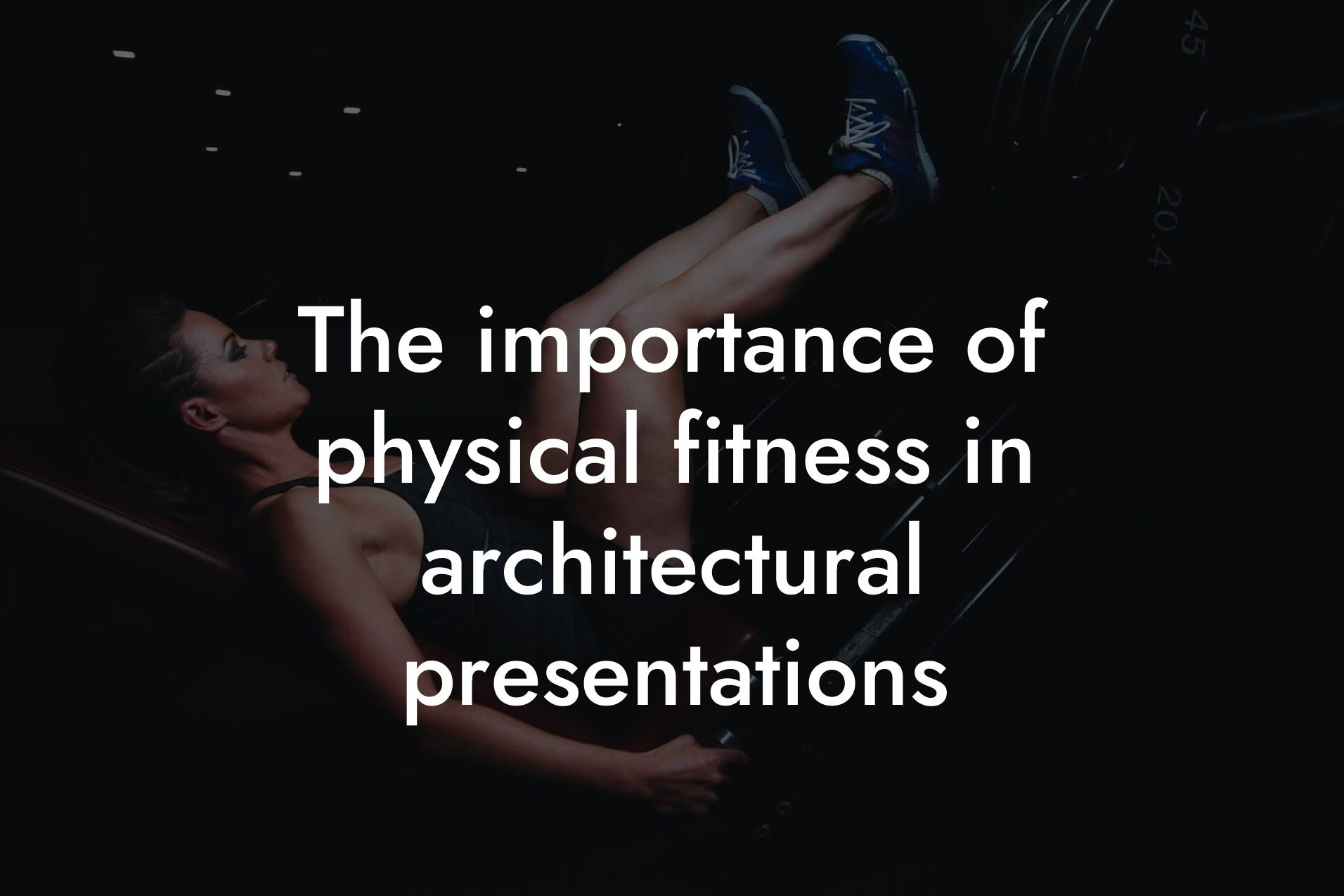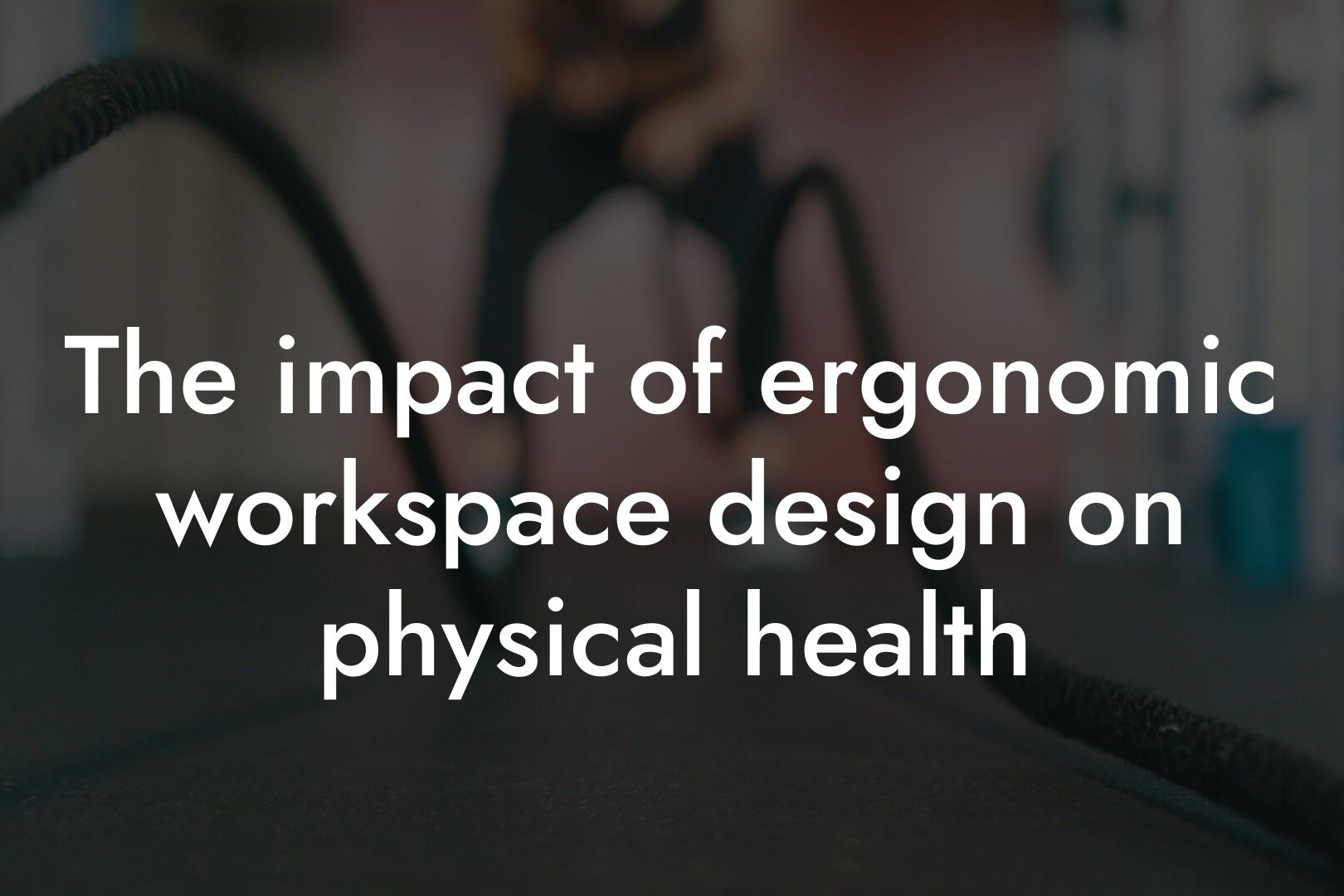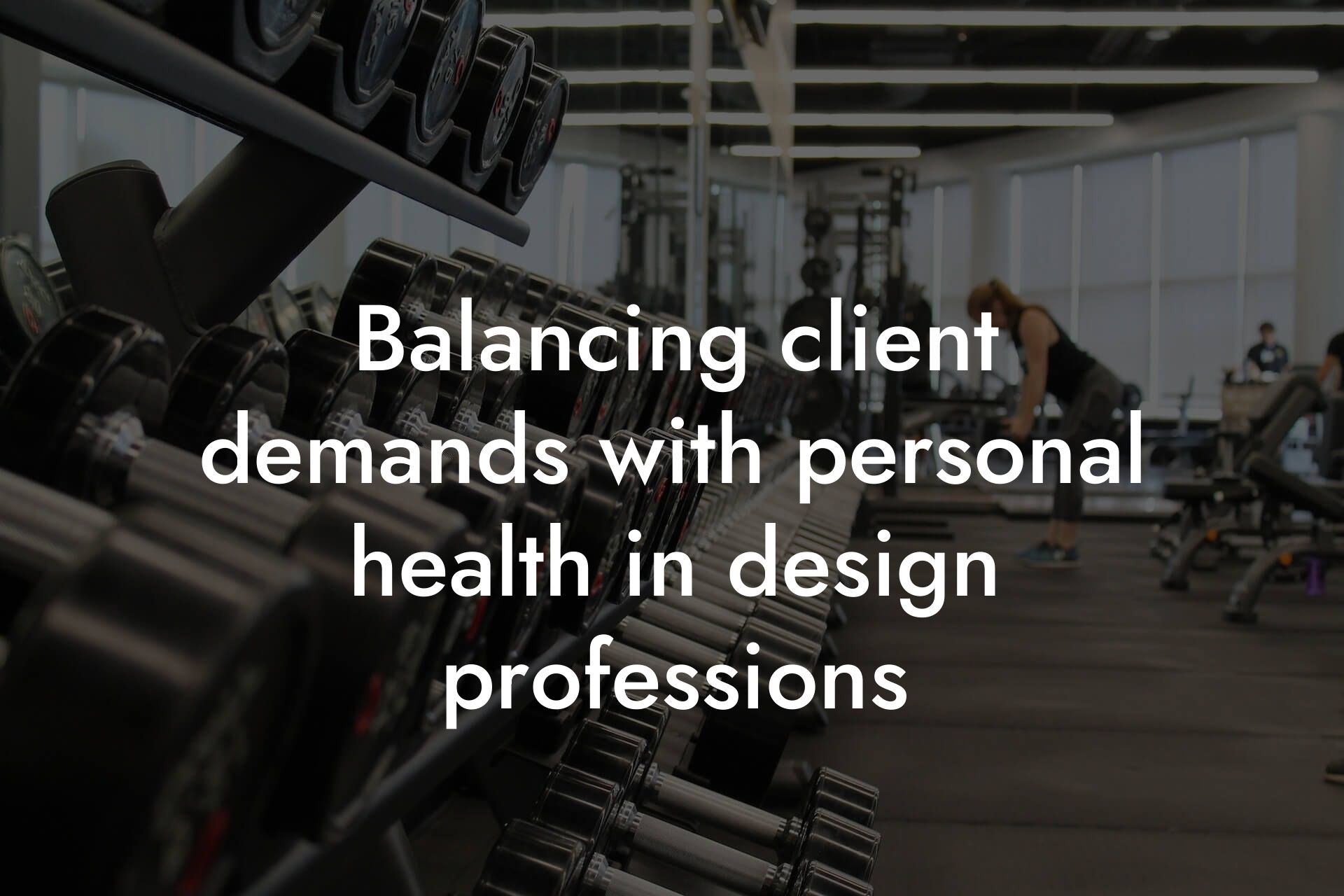As a high-earning professional, you understand the importance of maintaining a healthy work-life balance. However, with the demands of a design career, it can be challenging to prioritize physical health. Long hours spent sitting at a desk, staring at screens, and meeting tight deadlines can take a toll on your body. At Tano Performance Group, we recognize the importance of physical health in achieving overall success. In this article, we'll explore fitness strategies to help you balance your design work and physical health.
Table of Contents
- The Consequences of Neglecting Physical Health
- Understanding Your Body Composition
- Creating a Schedule That Works for You
- Incorporating Desk-Friendly Exercises
- High-Intensity Interval Training (HIIT) for Busy Designers
- Focusing on Functional Fitness
- Nutrition and Meal Planning for Designers
- Staying Motivated and Accountable
- Frequently Asked Questions
The Consequences of Neglecting Physical Health
Neglecting physical health can have severe consequences on your overall well-being and design career. Prolonged periods of inactivity can lead to weight gain, decreased energy levels, and a weakened immune system. This can result in decreased productivity, reduced creativity, and a higher risk of chronic diseases. Moreover, poor physical health can negatively impact your mental health, leading to anxiety, depression, and burnout.
Understanding Your Body Composition
Before developing a fitness strategy, it's essential to understand your body composition. At Tano Performance Group, we use DEXA scans to provide a comprehensive body assessment. This advanced technology measures body fat percentage, lean mass, bone density, and other vital metrics. With this information, you can create a personalized fitness plan tailored to your specific needs and goals.
Creating a Schedule That Works for You
One of the most significant challenges designers face is finding time to exercise. With tight deadlines and long hours, it can be tempting to put physical health on the backburner. However, incorporating fitness into your daily routine can be achieved with a little creativity. Try waking up 30 minutes earlier for a morning workout, using your lunch break for a quick exercise session, or scheduling workouts during your most productive hours.
Incorporating Desk-Friendly Exercises
As a designer, you likely spend a significant amount of time at your desk. While it's essential to take regular breaks, you can also incorporate desk-friendly exercises to stay active throughout the day. Try chair squats, desk push-ups, leg raises, or wrist extensions to keep your blood flowing and muscles engaged.
High-Intensity Interval Training (HIIT) for Busy Designers
HIIT is an excellent option for busy designers who need to maximize their workout time. This type of training involves short bursts of high-intensity exercise followed by brief periods of rest. HIIT can be adapted to any fitness level and can be done in as little as 10-15 minutes. Examples of HIIT workouts include sprints, burpees, jump squats, and mountain climbers.
Focusing on Functional Fitness
As a designer, you likely spend a lot of time sitting and using your hands. Functional fitness exercises can help improve your overall mobility, flexibility, and strength. Try incorporating exercises that target your core, legs, and glutes, such as squats, lunges, and deadlifts. These exercises can help improve your posture, reduce back pain, and increase your overall energy levels.
Nutrition and Meal Planning for Designers
A well-balanced diet is essential for maintaining physical health and supporting your design career. As a busy designer, it can be challenging to plan and prepare healthy meals. Try meal prepping on the weekends, keeping healthy snacks at your desk, and avoiding sugary drinks and processed foods. Focus on consuming lean proteins, complex carbohydrates, and healthy fats to fuel your body and mind.
Staying Motivated and Accountable
Staying motivated and accountable is crucial for maintaining a consistent fitness routine. Try finding a workout buddy, joining a fitness community, or hiring a personal trainer to keep you on track. Set realistic goals and celebrate your achievements, no matter how small they may seem. Remember, every step towards a healthier lifestyle is a step in the right direction.
As a high-earning professional, you understand the importance of prioritizing physical health. By incorporating fitness strategies into your daily routine, you can improve your overall well-being, increase productivity, and take your design career to the next level. At Tano Performance Group, we're committed to helping you achieve your fitness goals. With our comprehensive body assessment and personalized fitness plans, you can unlock your full potential and live a healthier, happier life.
Frequently Asked Questions
How can I balance my demanding design work with my physical health goals?
As a high-earning professional, it's essential to prioritize your physical health to maintain energy, focus, and overall well-being. Start by scheduling dedicated time for exercise and self-care, just as you would for work commitments. Even 30 minutes of moderate-intensity exercise per day can make a significant difference. Additionally, incorporate healthy habits into your daily routine, such as taking the stairs instead of the elevator, stretching during breaks, and preparing nutritious meals.
What are some effective time-management strategies for fitting in exercise and design work?
Effective time management is crucial for balancing design work and physical health. Try the Pomodoro Technique, which involves working in focused 25-minute increments, followed by a 5-minute break. Use this break to stretch, move around, or fit in a quick workout. You can also schedule your exercise routine during your lunch break or immediately after work to ensure it gets done.
How can I stay motivated to exercise when I have a tight deadline for a design project?
It's common to feel like exercise is a luxury you can't afford when facing a tight deadline. However, regular exercise can actually improve focus, creativity, and productivity. Remind yourself that taking short breaks to exercise can help you recharge and come back to your project with renewed energy and clarity. You can also try to find exercises that don't require a lot of time or equipment, such as bodyweight exercises or short HIIT sessions.
What are some healthy snack options that can fuel my brain and body for design work?
As a designer, you need snacks that provide sustained energy and support focus. Opt for nutrient-dense options like nuts, seeds, fruits, and veggies, which are rich in vitamins, minerals, and antioxidants. Avoid sugary or processed snacks that can lead to energy crashes and decreased productivity. Some healthy snack ideas include trail mix, energy balls, carrot sticks with hummus, and apple slices with almond butter.
How can I prioritize self-care when I'm working long hours on a design project?
Prioritizing self-care is essential for maintaining your physical and mental health, especially during long hours of design work. Make time for activities that bring you joy and relaxation, such as reading, meditation, or spending time with loved ones. Take regular breaks to stretch, move around, and rest your eyes. Also, establish a bedtime routine to ensure you're getting adequate sleep, which is critical for physical recovery and mental rejuvenation.
What are some exercises that can help improve my posture and reduce eye strain from design work?
As a designer, you likely spend a lot of time sitting in front of a computer, which can lead to poor posture and eye strain. Incorporate exercises that strengthen your core, shoulders, and back, such as planks, shoulder rolls, and chest opens. For eye strain, try the 20-20-20 rule: every 20 minutes, look away from your screen and focus on something 20 feet away for 20 seconds. You can also try eye exercises like focusing on a point and then shifting your gaze to another point.
How can I make healthy meal prep a part of my busy design schedule?
Healthy meal prep can be a game-changer for busy designers. Start by planning your meals for the week, considering your schedule and dietary needs. Then, dedicate one day a week to meal prep, where you cook and portion out healthy meals for the next few days. You can also prep individual ingredients, like roasted vegetables or cooked proteins, to make meal assembly easier during the week.
What are some stress-reducing techniques that can help me manage design project deadlines?
Stress is a common companion for designers facing tight deadlines. Try stress-reducing techniques like deep breathing exercises, progressive muscle relaxation, or meditation to help calm your mind and body. You can also use visualization techniques to imagine yourself successfully completing the project, or break down the project into smaller, manageable tasks to reduce feelings of overwhelm.
How can I get enough sleep when I have a design project deadline looming?
Adequate sleep is essential for physical recovery, mental rejuvenation, and focus. Establish a consistent sleep schedule, aiming for 7-9 hours of sleep each night. Create a bedtime routine to signal to your body that it's time to wind down, such as reading a book, taking a warm bath, or practicing gentle stretches. Avoid screens and stimulating activities at least an hour before bedtime, and make your sleep environment comfortable, dark, and quiet.
What are some exercises that can help improve my focus and concentration for design work?
Regular exercise can improve focus, concentration, and overall cognitive function. Try exercises that challenge your brain-body connection, such as yoga, tai chi, or balance exercises. You can also incorporate high-intensity interval training (HIIT) to improve cardiovascular health and boost energy levels. Additionally, try activities that require focus and concentration, such as puzzles, brain teasers, or strategy games.
How can I stay hydrated during long hours of design work?
Staying hydrated is essential for maintaining focus, energy, and overall health. Keep a water bottle nearby and aim to drink at least 8-10 glasses of water per day. Avoid sugary drinks and caffeine, which can lead to dehydration. You can also try herbal teas or coconut water for added hydration benefits. Monitor your urine output and color to ensure you're staying hydrated – if your urine is dark yellow or you're not urinating frequently enough, it may be a sign that you need to drink more water.
What are some healthy habits that can help me maintain a healthy weight as a designer?
Maintaining a healthy weight is crucial for overall health and well-being. As a designer, try to incorporate healthy habits into your daily routine, such as taking the stairs instead of the elevator, walking to meetings, or doing a few jumping jacks during breaks. Also, focus on whole, nutrient-dense foods like fruits, veggies, lean proteins, and whole grains, and limit your intake of processed and high-calorie foods.
How can I prioritize my physical health when I have a demanding design project?
Prioritizing your physical health is essential for maintaining energy, focus, and overall well-being, even when faced with a demanding design project. Schedule time for exercise and self-care, just as you would for work commitments. Remember that taking care of your physical health can actually improve your productivity and creativity, leading to better design outcomes.
What are some healthy ways to manage stress and anxiety as a designer?
Stress and anxiety are common companions for designers. Try healthy stress-management techniques like meditation, deep breathing exercises, or yoga to calm your mind and body. You can also try journaling, talking to a friend or mentor, or engaging in a hobby to help manage stress and anxiety. Remember to prioritize self-care and take breaks when needed to avoid burnout.
How can I make time for exercise when I have a busy design schedule?
Making time for exercise requires commitment and creativity. Try scheduling exercise into your daily routine, just as you would for work commitments. You can also try incorporating physical activity into your daily commute, such as walking or cycling to work. Additionally, find exercises that can be done in short intervals, such as bodyweight exercises or HIIT sessions, to fit into your busy schedule.
What are some healthy snack options that can help support my physical health goals?
Healthy snacking is essential for supporting your physical health goals. Opt for nutrient-dense snacks like fruits, veggies, nuts, and seeds, which provide sustained energy and support overall health. Avoid sugary or processed snacks that can hinder your progress. Some healthy snack ideas include energy balls, trail mix, carrot sticks with hummus, and apple slices with almond butter.
How can I stay motivated to prioritize my physical health as a designer?
Staying motivated to prioritize your physical health requires a mindset shift. Remember that taking care of your physical health is essential for maintaining energy, focus, and overall well-being. Celebrate small victories, like completing a workout or preparing a healthy meal, to help stay motivated. You can also find a workout buddy or accountability partner to help keep you on track.
What are some exercises that can help improve my bone density as a designer?
As a designer, you may be at risk for low bone density due to a sedentary lifestyle. Incorporate exercises that promote bone density, such as weight-bearing activities like walking, jogging, or weightlifting. You can also try high-impact exercises like jumping or dancing, or low-impact exercises like yoga or Pilates. Additionally, incorporate exercises that target your core and legs, such as squats, lunges, and deadlifts.
How can I prioritize my physical health when I'm working from home as a designer?
Working from home can make it challenging to prioritize your physical health. Create a dedicated workspace that promotes movement and stretching, such as a standing desk or a balance ball chair. Schedule time for exercise and self-care, just as you would for work commitments. You can also try incorporating physical activity into your daily routine, such as taking a walk during breaks or doing a few jumping jacks during commercial breaks.
What are some healthy habits that can help me maintain a healthy body fat percentage as a designer?
Maintaining a healthy body fat percentage is essential for overall health and well-being. As a designer, try to incorporate healthy habits into your daily routine, such as eating a balanced diet, staying hydrated, and getting regular exercise. Focus on whole, nutrient-dense foods like fruits, veggies, lean proteins, and whole grains, and limit your intake of processed and high-calorie foods. Additionally, try to get at least 7-9 hours of sleep per night to help regulate hormones and metabolism.
How can I make physical health a priority when I have a lot of design projects on my plate?
Making physical health a priority requires commitment and creativity. Schedule time for exercise and self-care, just as you would for work commitments. Remember that taking care of your physical health can actually improve your productivity and creativity, leading to better design outcomes. Try to find exercises that can be done in short intervals, such as bodyweight exercises or HIIT sessions, to fit into your busy schedule.
What are some healthy ways to manage stress and anxiety as a freelancer or entrepreneur in the design industry?
As a freelancer or entrepreneur in the design industry, you may face unique stressors and anxiety triggers. Try healthy stress-management techniques like meditation, deep breathing exercises, or yoga to calm your mind and body. You can also try journaling, talking to a friend or mentor, or engaging in a hobby to help manage stress and anxiety. Remember to prioritize self-care and take breaks when needed to avoid burnout.
How can I prioritize my physical health when I'm working long hours on a design project?
Prioritizing your physical health is essential for maintaining energy, focus, and overall well-being, even when working long hours on a design project. Schedule time for exercise and self-care, just as you would for work commitments. Remember to take regular breaks to stretch, move around, and rest your eyes. Also, establish a bedtime routine to ensure you're getting adequate sleep, which is critical for physical recovery and mental rejuvenation.
Here are some related articles you might love...
- The importance of physical fitness in architectural presentations
- The impact of ergonomic workspace design on physical health
- Balancing client demands with personal health in design professions
- How to avoid burnout through physical activity in architecture
- How DEXA scans can benefit architects and designers
- Nutrition for maintaining creativity and energy in design work
- The connection between body composition and creative output
- How architects can stay fit during long design sessions
- How to stay active during the design and build phases
Zak Faulkner
Zak Faulkner is a leading authority in the realm of physical health and body composition analysis, with over 15 years of experience helping professionals optimise their fitness and well-being. As one the experts behind Tano Performance Group, Zak has dedicated his career to providing in-depth, science-backed insights that empower clients to elevate their physical performance and overall health.
With extensive knowledge of DEXA technology, Zak specializes in delivering comprehensive body assessments that offer precise data on body fat, muscle mass, bone density, and overall physique. His expertise enables individuals to make informed decisions and achieve their fitness goals with accuracy and confidence. Zak’s approach is rooted in a deep understanding of human physiology, combined with a passion for helping clients unlock their full potential through personalised strategies.
Over the years, Zak has earned a reputation for his commitment to excellence, precision, and client-focused service. His guidance is trusted by top professionals who demand the best when it comes to their health. Whether advising on fitness programs, nutritional strategies, or long-term wellness plans, Zak Faulkner’s insights are a valuable resource for anyone serious about taking their health and fitness to the next level.
At Tano Performance Group, Zak continues to lead our Content Team revolutionising how professionals approach their physical health, offering unparalleled expertise that drives real results.




